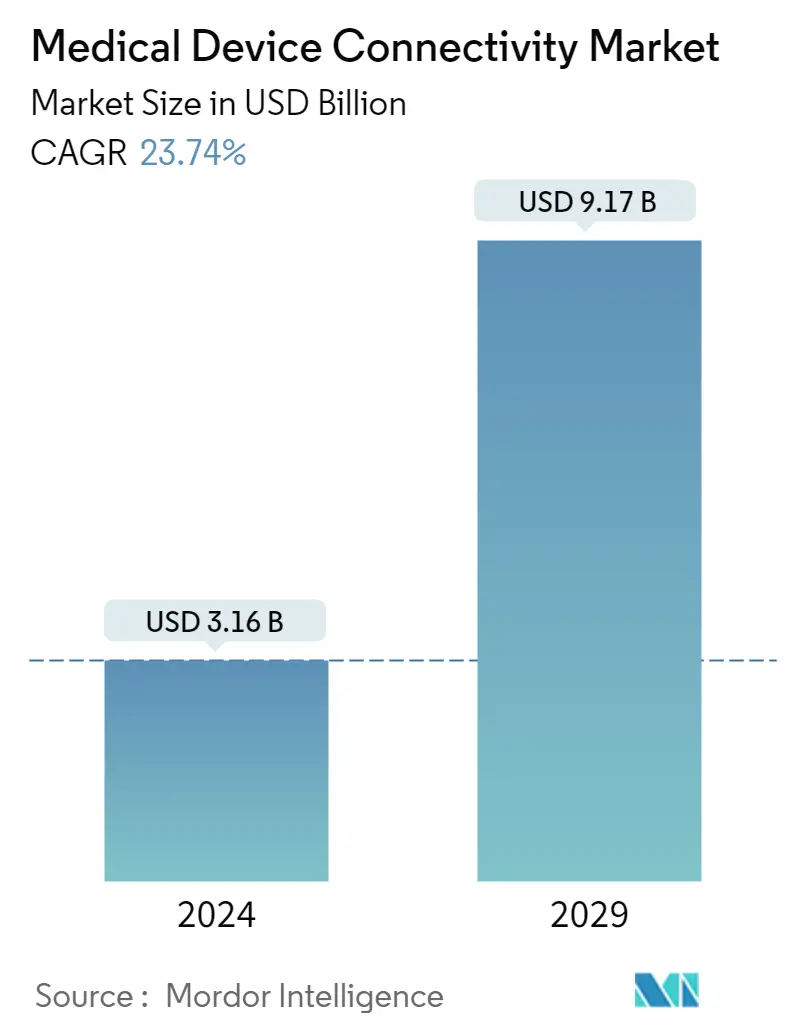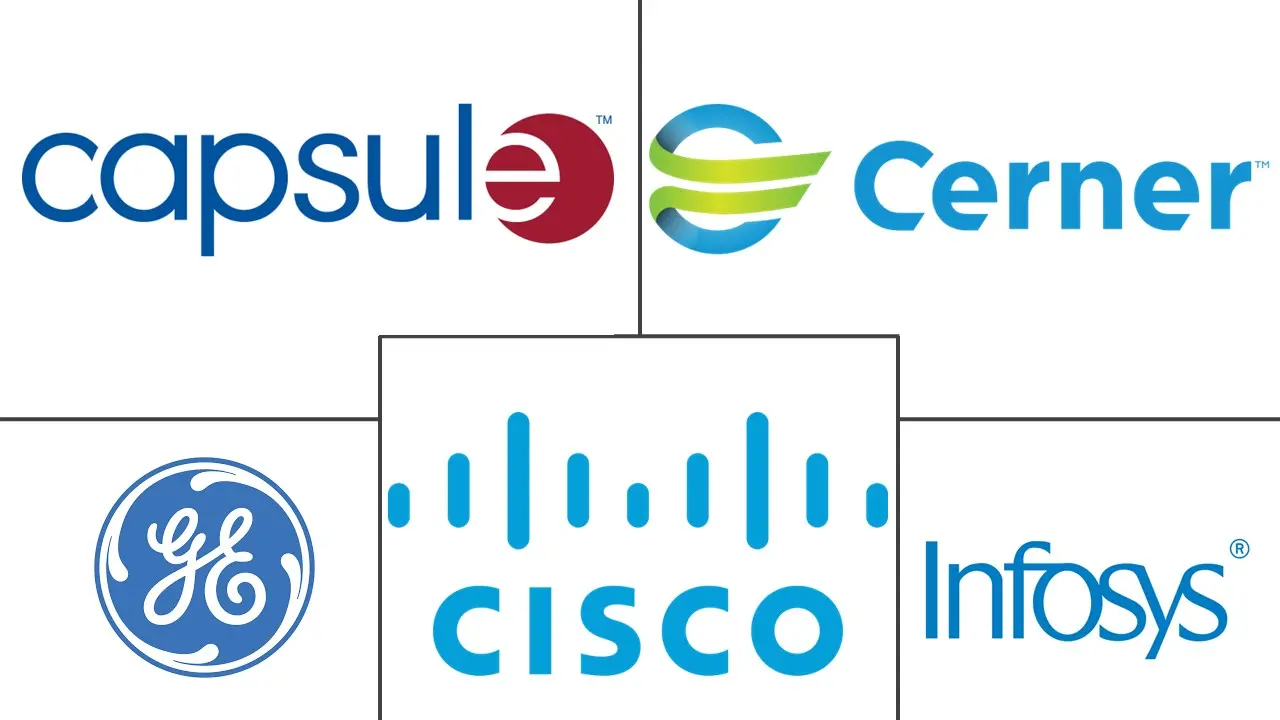Market Size of Medical Device Connectivity Industry

| Study Period | 2019 - 2029 |
| Market Size (2024) | USD 3.16 Billion |
| Market Size (2029) | USD 9.17 Billion |
| CAGR (2024 - 2029) | 23.74 % |
| Fastest Growing Market | Europe |
| Largest Market | North America |
Major Players
*Disclaimer: Major Players sorted in no particular order |
Medical Device Connectivity Market Analysis
The Medical Device Connectivity Market size is estimated at USD 3.16 billion in 2024, and is expected to reach USD 9.17 billion by 2029, growing at a CAGR of 23.74% during the forecast period (2024-2029).
Medical device connectivity is one of the industries that had a positive impact due to the COVID-19 pandemic owing to the extensive patient pool getting admitted to the hospital due to the infection. For instance, according to an article published by De Gruyter, in August 2021, Advances in the internet of medical things (IoMT) technology allow to connect of all medical tools, medical databases, and devices via the internet in one collaborative network, which conveys real-time data integration and analysis. IoMT framework-driven COVID-19 self-assessment tool captured signs and symptoms through multiple probing questions, storing the data in the COVID-19 patient database, then analyzing the data to determine whether a person needs to be tested for COVID-19 or other actions may require to be taken. Medical device connectivity system has demonstrated the ability to enhance health outcomes and reduce chaos during the pandemic, which made hospitals realize the advantage of medical device connectivity system over manual systems. Hence, the demand for medical device connectivity system systems increased, eventually driving the market growth.
The major factors for the growth of the market include the rising implementation of electronic health records and health information exchange systems, an increase in the demand for telehealth and telemedicine technologies, and technological advancements in wireless technologies and Bluetooth-enabled medical devices. For instance, according to an article published by Cox Communications, Inc., in May 2022, Bluetooth Low Energy (BLE) was developed and used Bluetooth technology to track. BLE makes use of software and gateways via cell phones and other devices. It enables low-power wireless technology, extending battery life while allowing devices to communicate with one another. The vast majority of smartphones and tablets are BLE compatible, making them perfect for closer contact. Furthermore, in September 2021, the Faculty of Sexual and Reproductive Healthcare (FSRH) and the Royal College of Obstetricians and Gynecologists (RCOG) joined forces to launch a new campaign to disseminate information about telemedicine for early medical abortion (EMA). Thus, the increasing adoption rate of telemedicine services is directly affecting the growth of the medical device connectivity market.
The companies are actively involved in new product launch developments and collaborations to expand their footprint. For instance, in October 2021, Royal Philips launched device drivers that enable integration and interoperability, Philips Capsule Medical Device Information Platform (MDIP). Philips Capsule MDIP integrated into the Philips HealthSuite Platform, installed in more than 3,000 healthcare facilities globally. Philips Capsule MDIP captures streaming clinical data and transforms it into actionable insights for patient care management, aiming to improve collaboration between care teams, streamline clinical workflows, and increase productivity. Such development is expected to drive the growth of the market over the forecast period.
Therefore, the factors mentioned above are attributed collectively to the studied market growth over the forecast period. However high cost of deployment and complete installation limiting the adoption of advanced solutions are expected to hinder market growth over the forecast period.
Medical Device Connectivity Industry Segmentation
As per the scope of the report, medical device connectivity is the formation and maintenance of a connection through which data is transferred between a medical device, such as a patient monitor and an information system. The Medical Device Connectivity Market is segmented by Products and Services (Medical Device Connectivity Solutions and Medical Device Connectivity Services), Technology (Wired Technologies, Wireless Technologies, and Hybrid Technologies), End User (Hospitals, Ambulatory Care Centers, and Others), and Geography (North America, Europe, Asia-Pacific, Middle East and Africa, and South America). The market report also covers the estimated market sizes and trends for 17 different countries across major regions globally. The report offers the value (in USD million) for the above segments.
| By Product & Service | |
| Medical Device Connectivity Solutions | |
| Medical Device Connectivity Services |
| By Technology | |
| Wired Technologies | |
| Wireless Technologies | |
| Hybrid Technologies |
| By End User | |
| Hospitals | |
| Ambulatory Care Centers | |
| Others |
| Geography | ||||||||
| ||||||||
| ||||||||
| ||||||||
| ||||||||
|
Medical Device Connectivity Market Size Summary
The medical device connectivity market is experiencing significant growth, driven by the increasing integration of advanced technologies in healthcare. The COVID-19 pandemic highlighted the importance of connectivity systems, as they facilitated real-time data integration and analysis, improving health outcomes and operational efficiency in hospitals. The rise in telehealth and telemedicine, coupled with advancements in wireless technologies like Bluetooth Low Energy, has further propelled market expansion. Companies are actively launching new products and forming collaborations to enhance their offerings, such as Philips' integration of the Capsule Medical Device Information Platform into its HealthSuite Platform. Despite the high costs associated with deployment and installation, the demand for advanced connectivity solutions continues to rise, indicating a robust growth trajectory for the market.
In North America, the medical device connectivity market is rapidly expanding due to the increasing prevalence of chronic diseases and the high adoption of healthcare technologies. The growing healthcare expenditure in the region is creating opportunities for telemedicine, which is expected to drive market growth. Government initiatives and corporate innovations, such as the FDA's focus on AI/ML-enabled medical devices, are further supporting this growth. The market is characterized by a consolidated competitive landscape, with key players like Capsule Technologies, Cerner Corporation, and GE Healthcare leading the charge. As the demand for wireless medical device connectivity increases, the market is poised for substantial growth over the forecast period.
Medical Device Connectivity Market Size - Table of Contents
-
1. MARKET DYNAMICS
-
1.1 Market Overview
-
1.2 Market Drivers
-
1.2.1 Rising Implementation of Electronic Health Records and Health Information Exchange Systems
-
1.2.2 Increase in the Demand for Telehealth and Telemedicine Technologies
-
1.2.3 Technological Advancements in Wireless Technologies and Bluetooth-Enabled Medical Devices
-
-
1.3 Market Restraints
-
1.3.1 High Cost of Deployment and Complete Installation Limiting the Adoption of Advanced Solutions
-
1.3.2 Data Privacy and Security Concerns
-
-
1.4 Porter Five Forces
-
1.4.1 Threat of New Entrants
-
1.4.2 Bargaining Power of Buyers/Consumers
-
1.4.3 Bargaining Power of Suppliers
-
1.4.4 Threat of Substitute Products
-
1.4.5 Intensity of Competitive Rivalry
-
-
-
2. MARKET SEGMENTATION
-
2.1 By Product & Service
-
2.1.1 Medical Device Connectivity Solutions
-
2.1.2 Medical Device Connectivity Services
-
-
2.2 By Technology
-
2.2.1 Wired Technologies
-
2.2.2 Wireless Technologies
-
2.2.3 Hybrid Technologies
-
-
2.3 By End User
-
2.3.1 Hospitals
-
2.3.2 Ambulatory Care Centers
-
2.3.3 Others
-
-
2.4 Geography
-
2.4.1 North America
-
2.4.1.1 United States
-
2.4.1.2 Canada
-
2.4.1.3 Mexico
-
-
2.4.2 Europe
-
2.4.2.1 Germany
-
2.4.2.2 United Kingdom
-
2.4.2.3 France
-
2.4.2.4 Italy
-
2.4.2.5 Spain
-
2.4.2.6 Rest of Europe
-
-
2.4.3 Asia-Pacific
-
2.4.3.1 China
-
2.4.3.2 Japan
-
2.4.3.3 India
-
2.4.3.4 Australia
-
2.4.3.5 South Korea
-
2.4.3.6 Rest of Asia-Pacific
-
-
2.4.4 Middle-East and Africa
-
2.4.4.1 GCC
-
2.4.4.2 South Africa
-
2.4.4.3 Rest of Middle East and Africa
-
-
2.4.5 South America
-
2.4.5.1 Brazil
-
2.4.5.2 Argentina
-
2.4.5.3 Rest of South America
-
-
-
Medical Device Connectivity Market Size FAQs
How big is the Medical Device Connectivity Market?
The Medical Device Connectivity Market size is expected to reach USD 3.16 billion in 2024 and grow at a CAGR of 23.74% to reach USD 9.17 billion by 2029.
What is the current Medical Device Connectivity Market size?
In 2024, the Medical Device Connectivity Market size is expected to reach USD 3.16 billion.

